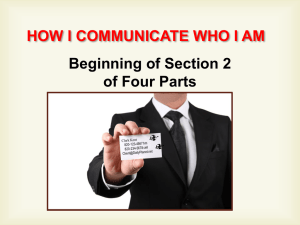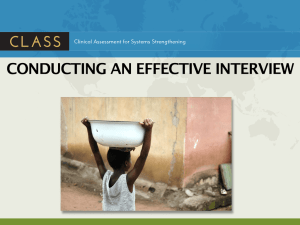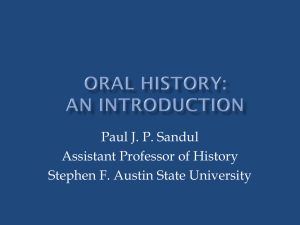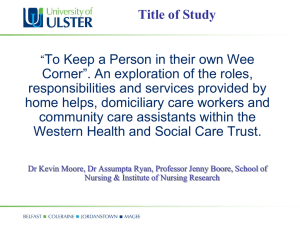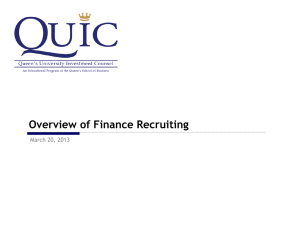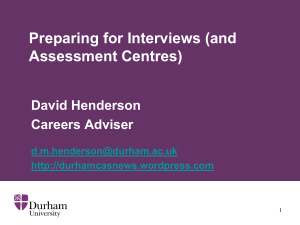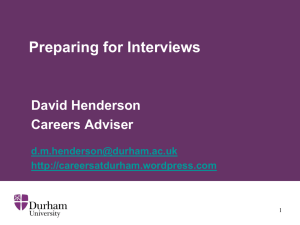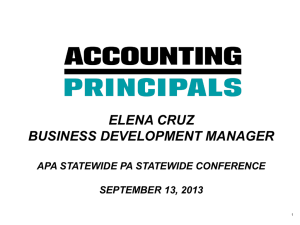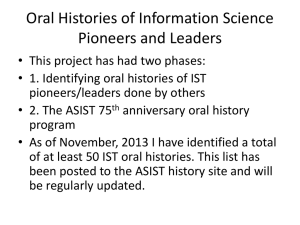Writing Oral History
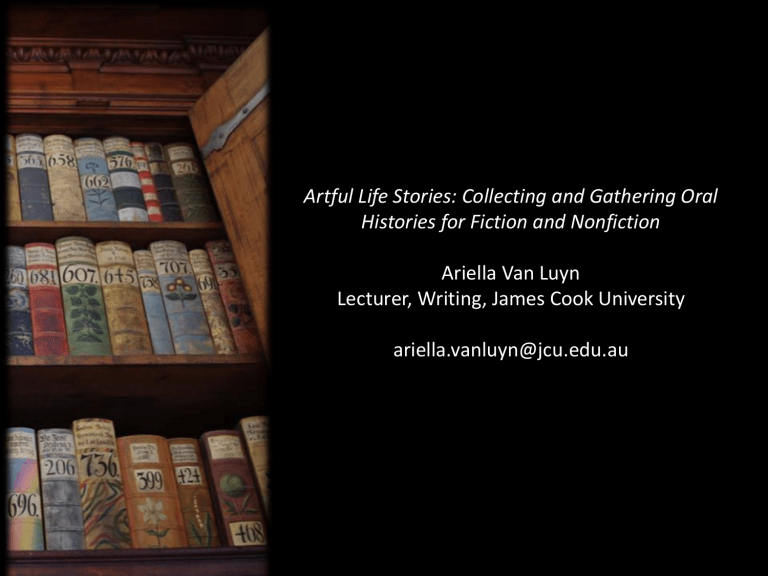
Artful Life Stories: Collecting and Gathering Oral
Histories for Fiction and Nonfiction
Ariella Van Luyn
Lecturer, Writing, James Cook University ariella.vanluyn@jcu.edu.au
Writers in Townsville Anthology
•
Due 31 March
•
Nonfiction only
How I came to be involved in oral history:
• Honours and practice-led PhD in creative writing, investigating the fictionalising of oral history.
• Joined the Oral History Association of Australia, Queensland. President
2011-2012.
• Queensland Business Leaders Hall of
Fame.
• Cardwell and Cyclone Yasi.
• Novel Hidden Objects based on oral histories and shortlisted for
Queensland Literary Awards 2012,
Unpublished Manuscript Category.
What is oral history?
• Semi-structured interview,
• Conducted by a interviewer who has researched the subject,
• About the interviewee’s first hand experience,
• which is recorded.
Why oral history?
• Rich source of details that are sometimes missing from historical records.
• The voice of the interviewee is evocative and often filled with the vocabulary of previous eras.
• Oral storytelling reveals the personal significance of events and experiences.
Frank Warren, Post Secret
Frank Warren, Post Secret
Steps in an oral history project:
1. Create a vision for your project that is achievable.
2. Consider what resources are available: people, research material, community spaces, organisations.
3. Prepare budget.
4. Think about who you will interview and for how long.
Steps in an oral history project:
4. Organise recording equipment.
5. Write ethics and permission forms.
6. Conduct research.
7. Consider interview questions.
8. Interviews: who, when and where?
Steps in an oral history project:
9. Transcription.
10. Presentation: editing audio and transcripts.
Plan each of these steps before you begin, but be prepared to be flexible.
Reflect and re-plan throughout.
Ethics: treating life stories with respect
• Ensure that the interviewee understands how you will use their interview.
• Get it in writing.
• This helps to build a relationship of trust.
• In the oral history context, interviewees should never feel pressured to tell their stories. Paul Rosenblatt (2003): ‘entitlement to deceive.’
An ethical interviewer is:
• Friendly
• Approachable
• Flexible
• Honest
• Articulate
• Aware of the interviewees’ wants, needs and unique situation and view of reality.
• Well informed through research and prior conversations with interviewee
The interviewer is responsible for:
• Explaining the purpose of the interview and the project and who owns copyright;
• Giving each interviewee an agreement to sign;
• Conducting interviews with objectivity, honesty and integrity;
• Being aware of defamation laws;
• Treating every interview as a confidential conversation until an interviewee gives the right to share information through an agreement;
• Ensuring that interviewees are given the opportunity to review, correct and/or withdraw material;
• Allowing the interview to be access by future researchers in a way agreeable to the interviewee.
Copyright
• The interviewees own their words.
• You can ask permission to use their words in your writing, either by licensing you to use them or by assigning copyright to you.
• This is included in your information and consent form.
Developing questions
• Create open ended questions.
Compare:
Q: ‘When was that?’
A: ‘I don’t know.’
To:
Q: ‘What else was happening in your life at that time?’
• If you do ask closed questions
(sometimes you might have to), follow it up with an open ended question.
e.g. Q: So you were there?
A: Yes.
Q: Can you tell me about it?
Developing questions
• Ask yourself the questions: do you get meaningful answers?
• Try to avoid questions that are too general or abstract — ask questions relevant to your interviewees unique situation .
• Ask questions that speak to a variety of ways of experiencing the world: emotions and sensory details.
Evoking the past and present through arts-based methods
Maps, relational maps, self-portrait, timelines
Avoid judgmental questions
Art Spiegelman Maus
(2003)
Ending
• Finish with two questions:
Is there anything I haven’t asked you’d like to talk about?
Is there anything you’d like to say more about?
In a bigger project: who else do you know who would like to be interviewed?
A well structured interview will have an arc: we see how the interviewee has changed as a result of their experience.
In the interview
• Don’t be afraid to stray from your prepared questions.
• Follow up points that interest you.
Ask for details (sometimes this is not obvious until you listen to the interview again).
• Good stories appear unexpectedly.
Go with the flow.
• Avoid interrupting the interviewee. If you think of a question while the interviewee is talking, write it down.
In the interview
• Interview doesn’t have to grind to a halt because the interviewee can’t remember something. Say, ‘it doesn’t matter, you might remember later.’
• Allow the interviewee to speak and also to think. Let silences happen.
• Listen closely.
• If you need to ask difficult questions later in the interview, when you feel you have built a strong enough relationship with the interviewee.
In the interview
• Interviews are context dependant:
Where are you conducting the interview?
How will the place effect what the interviewee will say and their comfort?
• An interviewee may not tell you something because they find it hurtful, embarrassing or that it doesn’t fit into their idea of themselves or how they want to represent themselves to you.
• You don’t have to force the interviewee to tell you. You just need to be aware of all these problems when conducting and understanding the interview.
• Interviews are messy and organic. Why?
Personalities, cultural and social influences, agendas, awareness of the purpose of the interview, the problems of memory.
• Interviews are a dialogue: the interviewer is always implicated its creation.
• Who you are as an interviewer will effect the outcome:
How will your position in relation to the project effect what the interviewee will say?
How will you represent yourself before and after the interview?
Telling life stories
• An oral testimony cannot be treated as only a repository of facts and errors of facts’ (Tonkin,
1992, 12).
• Oral history interviews are evidence of the way we understand the past (Firsch cited in
Grele, 2006, 58).
• Hayden White (1997, 170): the real world is
‘inherently random and meaningless, and that humans confer meaning by imposing narrative structure.’
• Problems of memory: e.g. Al Thomson’s
ANZAC interviews
The past is another country, they do things differently there; and we are no longer they.
The shadow past is shaped by everything that never happened. Invisible, it melts the present like rain through karst. A biography of longing.
It steers us like magnetism, a spirit torque. This is how one becomes undone by a smell, a word, a place, the photo of a mountain of shoes. By love that closes its mouth before calling a name.
I did not witness the most important events of my life. My deepest story must be told by a blind man, a prisoner of sound.
(Anne Michaels. Fugitive pieces. p.17)
Thinking about your end product
•
Edited transcripts,
•
Interviews integrated into a historical account,
•
Digital stories,
•
Fictionalised narratives,
•
Art exhibitions,
•
Museum displays.
Image: Fiona Davies, Intangible Collection
Transcribing
What do you think this voice sounds like?
What has happened to the human voice? Vox Humana.
Hollering, shouting, quiet talking, buzz.
I was leaving the airport, this was in Altanta. You know, you leave the gate, you take a train that took you to concourse of your choice and I get onto this train. Dead silence. A few people seated, or standing. Up above you hear a voice. Not a human voice but you know, talks like a machine. Concourse one,
Farnsworth, Dallas, Roebuck. That kind of voice. Just when the doors were about to close, automatic doors, only a couple rush in and push open the doors and get in.
Story Corps, Studs Terkel, The Sound of the Human Voice http://storycorps.org/listen/stories/studsterkel/?sms_ss=email&at_xt=4d951046685fbd7d%2C0
The problems with transcribing
‘The Sound of the Human voice’ transcript demonstrates that:
• Transcription, no matter how skilful, inevitably flattens the spoken quality of oral memoirs (Berger Gluck, 1999).
• Transcription is also time consuming. It takes between 4 to 6 hours to type one hour of written interview, depending on the quality of the recording, skills of the typist and the complexity of the interview.
Why transcribe?
• Transcription makes the information easier to present in exhibits, publications and other research outputs.
• Transcripts are more ‘searchable.’
• Interviewees may prefer written to oral recordings. Often more prestige is attached to written documents.
• Interviewee can correct spelling and any misheard or misunderstood information.
• Audios formats may change, but paper based copies will always be readable.
Decisions, decisions…
• Hesitations, repetitions, and ‘redundant’ words are rich in communicative value, and deleting them distorts the narrator’s intended message
(Moore, 1997)
• Bowden (2005) advocates preserving oral testimony ‘ “as she is spoke” on the printed page.
But encourages ‘tidying up’ the transcript by removing ‘ums’, redundant words and long silences—so long as the character and the sense of the interviewee is not lost in the process.
And more decisions…
Michael Frisch (1990):
• depends on the purpose.
• aggressive editing and manipulation is often necessary when translating an interview into a different medium of communication.
• reproducing non-standard vocalisations can make the text so incoherent that it is an obstacle both to conveying the narrator’s meaning and to capturing the ‘texture and feel’ of voice and character.
Punctuation
Beth Robinson (2006) Oral History Handbook:
• Single dashes indicate pauses within sentences;
• Three dashes indicate unfinished sentences;
• Don’t use ellipses (...) as, in academic language, this indicates that material has been left out
• Put non verbal actions (laughing, gestures) in brackets
• Square brackets around information not in the recording
Proofreading
• The person who conducted the interview should always proofread a draft.
• Interviewee should also proofread. While typing, underline words that you’re unsure how to spell to ensure interviewee will correct them.
• HOWEVER when you send a transcript to an interviewee warn them in a cover letter that it is meant to be a verbatim transcript of their words.
Many will be horrified by how they sound when they speak and will want to change it.
Proofreading
• Make changes and send interviewee a clean copy. Get them to sign the bottom of the approved copy.
• Send interviewees copy of final interview audio, transcript and any images you took or scanned.
Edited oral history
• Miguel Barnet and Esteban Montejo,
Biography of a Runaway Slave
Oral history as part of an historical account
• Helen Klaebe, Sharing Stories: A Social
History of Kelvin Grove Urban Village
